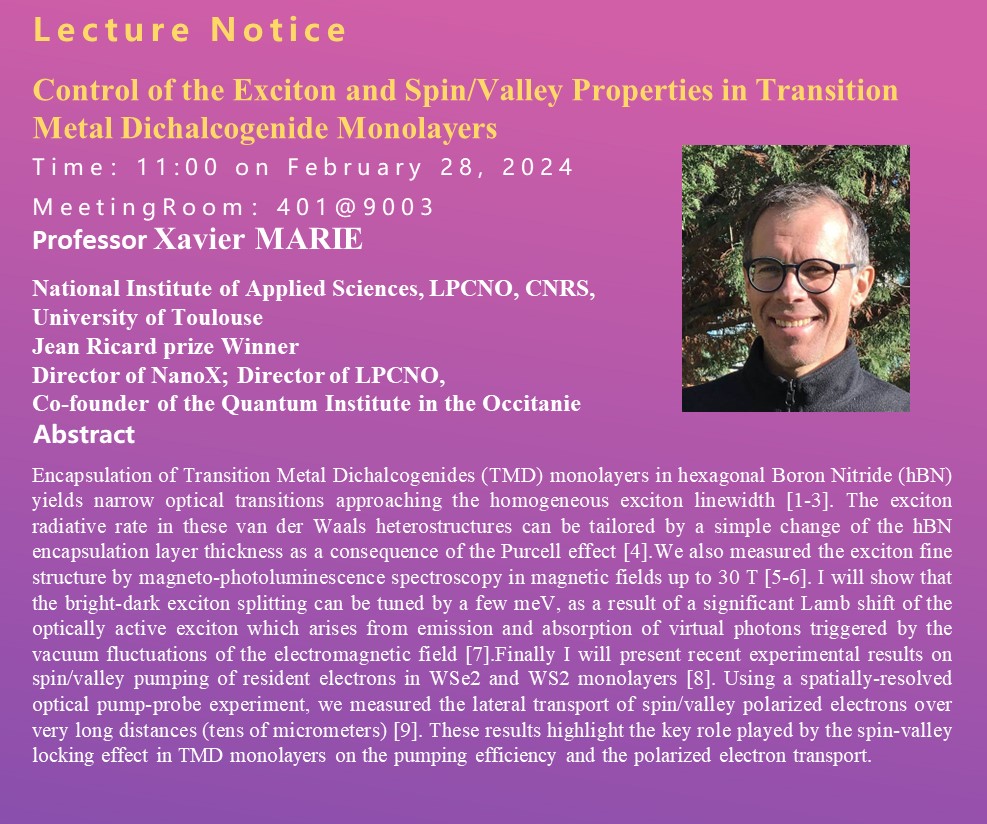Lecture Notice|Xavier Marie , Control of the Exciton and Spin/Valley Properties in Transition Metal Dichalcogenide Monolayers

Control of the Exciton and Spin/Valley Properties in Transition Metal Dichalcogenide Monolayers
Time:11:00, February 28, 2024
MeetingRoom:401@9003
Abstract:
Encapsulation of Transition Metal Dichalcogenides (TMD) monolayers in hexagonal Boron Nitride (hBN) yields narrow optical transitions approaching the homogeneous exciton linewidth [1-3]. The exciton radiative rate in these van der Waals heterostructures can be tailored by a simple change of the hBN encapsulation layer thickness as a consequence of the Purcell effect [4].
We also measured the exciton fine structure by magneto-photoluminescence spectroscopy in magnetic fields up to 30 T [5-6]. I will show that the bright-dark exciton splitting can be tuned by a few meV, as a result of a significant Lamb shift of the optically active exciton which arises from emission and absorption of virtual photons triggered by the vacuum fluctuations of the electromagnetic field [7].
Finally I will present recent experimental results on spin/valley pumping of resident electrons in WSe2 and WS2 monolayers [8]. Using a spatially-resolved optical pump-probe experiment, we measured the lateral transport of spin/valley polarized electrons over very long distances (tens of micrometers) [9]. These results highlight the key role played by the spin-valley locking effect in TMD monolayers on the pumping efficiency and the polarized electron transport.
[1] G. Wang et al, Rev. Mod. Phys. 90, 021001 (2018)
[2] F. Cadiz et al, Phys. Rev. X 7, 021026 (2017)
[3] G. Wang et al, Phys. Rev. Lett. 119, 047401 (2017)
[4] H. Fang et al, Phys. Rev. Lett. 123, 067401 (2019)
[5] C. Robert et al, Phys. Rev. Lett . 126, 067403 (2021)
[6] C. Robert et al, Nature Com. 11, 4037 (2020)
[7] L. Ren et al, Phys. Rev. Lett 131, 116901 (2023)
[8] C. Robert et al, Nature Com. 12, 5455 (2021)
[9] C. Robert et al, Phys. Rev. Lett. 129, 027402 (2022)
Biography:
Xavier Marie is a Professor at the National Institute of Applied Sciences (INSA- University of Toulouse). He joined the Institut Universitaire de France (IUF) in 2005 as a Junior member and in 2015 as a Senior member. He is currently in charge of the Laboratory of Excellence NanoX, which brings together 200 permanent researchers from 6 research laboratories in Toulouse. He is also the co-founder of the Quantum Institute in the Occitanie Region, created in 2020. He was the Director of the Laboratory of Physics and Chemistry of Nano-Objects (LPCNO ; CNRS UMR 5215) that he created from 2007 to 2010.
He has worked for about 30 years on electronic and optical spectroscopy of low-dimensional semiconductor structures (quantum wells, quantum dots, 2D materials). His main present interest is the optical, valley, and spin properties of various van der Waals heterostructures and band structure engineering of semiconductors for optical telecommunication devices, solar cells, and quantum technology devices.
He is the author or co-author of about 390 papers in refereed journals, 2 books, 12 book chapters, and 5 patents (h=67). He gave 140 invited talks in International Conferences and seminars and 15 lectures in International Summer Schools. He has been chairman or co-chairman of 10 international conferences or workshops. He is a regular expert and member of panels for EPSRC (United Kingdom), Department of Energy (USA), DFG (Germany), SNSF (Switzerland), SFI (Ireland), ERC (Europe), CAS (China), ANR (France)...He has been a member of the editorial board of Physical Review X (American Physics Society) since 2018 and a member of the International Union of Pure and Applied Physics (IUPAP), since 2021. He received the Jean Ricard prize from the French Society of Physics in 2019, the “Palmes Académiques-Officer” in 2020, and is one of the highly Cited Researchers in 2021 and 2022 (Web of Science, Clarivate).




